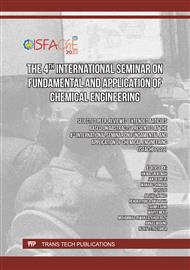[1]
Sulaeman, B, Modulus elastisitas berbagai jenis material, Pena Teknik: Jurnal Ilmiah Ilmu-ilmu Teknik. 3(2) (2018) 127-138.
DOI: 10.51557/pt_jiit.v3i2.176
Google Scholar
[2]
Pratiwi, R., Rahayu, D., & Barliana, M. I, Pemanfaatan selulosa dari limbah jerami padi (Oryza sativa) sebagai bahan bioplastik. Indonesian Journal of Pharmaceutical Science and Technology. 3(3) (2016) 83-91.
DOI: 10.15416/ijpst.v3i3.9406
Google Scholar
[3]
Saidah, Andi, Sri Endah Susilowati, and Yos Nofendri. Analisa perbandingan kekuatan tarik dan impak komposit serat jerami padi polyester dengan komposit serat jerami padi-epoxy dengan metode hand lay up, Prosiding Snast (2018) 291-298.
DOI: 10.21009/jkem.5.2.7
Google Scholar
[4]
Dantes, Kadek Rihendra. Composites Manufacturing and Testing-Rajawali Pers. PT. RajaGrafindo Persada, 2021.
Google Scholar
[5]
Maryanti, B., Sonief, A. A. A., & Wahyudi, S. Pengaruh Alkalisasi Komposit Serat Kelapa-Poliester Terhadap Kekuatan Tarik. Rekayasa Mesin. 2(2) (2011) 123-129.
DOI: 10.21776/ub.jrm.2015.006.01.5
Google Scholar
[6]
Sulaeman, B. Modulus elastisitas berbagai jenis material. Pena Teknik: Jurnal Ilmiah Ilmu-ilmu Teknik 3(2) (2018) 127-138.
DOI: 10.51557/pt_jiit.v3i2.176
Google Scholar
[7]
Adryani, R. Pengaruh ukuran partikel dan komposisi abu sekam padi hitam terhadap sifat kekuatan tarik komposit poliester tidak jenuh. Jurnal Teknik Kimia USU. 3(4) (2014) 31-36.
DOI: 10.32734/jtk.v3i4.1653
Google Scholar
[8]
Manar Haq, S., & Kadir, Y. Kajian Pengaruh Penambahan Kalsium Karbonat Sebagai Microfiller Terhadap Kuat Tekan Beton Polimer. In Prosiding SoBAT (Seminar Sosial Politik, Bisnis, Akuntansi dan Teknik) Universitas Sangga Buana YPKP. 1(1) (2019) 78-84.
DOI: 10.32897/sobat3.2021.3
Google Scholar
[9]
Widiyono, E., Mahdum, M. Y., Rahman, H., & Noor, D. Z. Komposit Carbon Fiber Sandwich Sebagai Bahan Alternatif Pengganti Alumunium Alloy 6063 Pada Knuckle Plate Mobil Nogogeni 5 EVO. Jurnal Nasional Aplikasi Mekatronika, Otomasi dan Robot Industri (AMORI). 2(1). 2021.
DOI: 10.12962/j27213560.v2i1.9120
Google Scholar
[10]
Akil, HMl, et al. Kenaf fiber reinforced composites: A review. Materials & Design 32.8-9 (2011) 4107-4121.
DOI: 10.1016/j.matdes.2011.04.008
Google Scholar
[11]
Jiang, Y., Bourebrab, M. A., Sid, N., Taylor, A., Collet, F., Pretot, S., & Lawrence, M. Improvement of water resistance of hemp woody substrates through deposition of functionalized silica hydrophobic coating, while retaining excellent moisture buffering properties. ACS Sustainable Chemistry & Engineering. 6(8) (2018) 10151-10161.
DOI: 10.1021/acssuschemeng.8b01475
Google Scholar
[12]
Butar Butar, Josua Goklas, and Pradana Setyo Darminto. Pengaruh Tekanan Oksigen Terhadap Delignifikasi Pada Proses Pulping. Diss. Institut Teknologi Sepuluh Nopember, 2018.
Google Scholar
[13]
Ahyar, Riadhi, Anis Rakhmawati, and Yudhi Arnandha, Kuat lentur balok komposit dari serat rayung dengan matriks lem kayu menggunakan metode kempa dingin. Jurnal Rekayasa Infrastruktur Sipil 1.2 (2021).
DOI: 10.31002/.v1i2.3389
Google Scholar
[14]
Harsi, H., Sari, N. H., & Sinarep, S. Karakteristik Kekuatan Bending Dan Kekuatan Tekan Komposit Serat Hybrid Kapas/gelas Sebagai Pengganti Produk Kayu. Dinamika Teknik Mesin: Jurnal Keilmuan dan Terapan Teknik Mesin, 5(2). (2015).
DOI: 10.29303/d.v5i2.30
Google Scholar
[15]
Rahayu, S., & Siahaan, M. Karakteristik Raw Material Epoxy Resin Tipe BQTN-EX 157 Yang Digunakan Sebagai Matrik Pada Komposit. Jurnal Teknologi Dirgantara, 15(2), (2017). 151-160.
DOI: 10.30536/j.jtd.2017.v0.a2526
Google Scholar
[16]
Fatriasari, Widya, Nanang Masruchin, and Euis Hermiati. Selulosa: karakteristik dan pemanfaatannya. (2019).
Google Scholar
[17]
Lamtiar, H., and E. Yenie. Isolasi Lignin dari Jerami Padi dengan Metoda Klason. Diss. Riau University, 2015.
Google Scholar
[18]
Shabiri, M., Pengaruh Rasio Epoksi Ampas Tebu Dan Perlakuan Alkali Pada Ampas Tebu Terhadap Kekuatan Bentur Komposit Partikel Epoksi Berpengisi Serat Ampas Tebu, Jurnal Teknik, Departemen Teknik Kimia, Fakultas Teknik, Universitas Sumatera Utara. 2014.
DOI: 10.32734/jtk.v3i3.1638
Google Scholar
[19]
Mawardi, Indra, and Hasrin Lubis. Proses Manufaktur Plastik dan Komposit. Penerbit Andi, 2019.
Google Scholar
[20]
Sari, N. H. Kekuatan mekanik komposit diperkuat serat alam selulosa. Dinamika Teknik Mesin. 8(2) (2018) 52-57.
DOI: 10.29303/d.v4i1.68
Google Scholar
[21]
Information on https://bsilhk.menlhk.go.id/standarlhk/2022/09/13/sni-01-4449-2006-papan-serat/ Indonesian National Standard for fiberboard (SNI 01-4449-2006).
Google Scholar
[22]
Dynanty, S. D. P., & Mahyudin, A. Pengaruh Panjang Serat Pinang Terhadap Sifat Mekanik dan Uji Biodegradasi Material Komposit Matriks Epoksi dengan Penambahan Pati Talas. Jurnal Fisika Unand. 7(3) (2018). 233-239.
DOI: 10.25077/jfu.7.3.233-239.2018
Google Scholar
[23]
Fadhillah, A. R., Hermawan, D., & Wardhani, A. R. Pengaruh prosentase larutan NaOH pada proses alkalisasi serat kulit pohon waru (hibiscus tiliaceus) sebagai reinforcement komposit terhadap kekuatan tarik serat tunggal. Turbo: Jurnal Program Studi Teknik Mesin, 8(2). 2020.
DOI: 10.24127/trb.v8i2.1159
Google Scholar
[24]
Information on https://bsilhk.menlhk.go.id/standarlhk/2022/09/13/sni-03-2105-2006-papan-partikel/ Indonesian National Standard for particleboard (SNI 03-2105-2006).
Google Scholar
[25]
Kusumo, P., Biyono, S., & Tegar, S. Isolasi Lignin dari Serbuk Grajen Kayu Jati (Tectona Grandis) dengan Metode Klasson. Jurnal Teknik: Media Pengembangan Ilmu dan Aplikasi Teknik, 19(2). (2020). 130-139.
DOI: 10.26874/jt.vol19no02.158
Google Scholar



